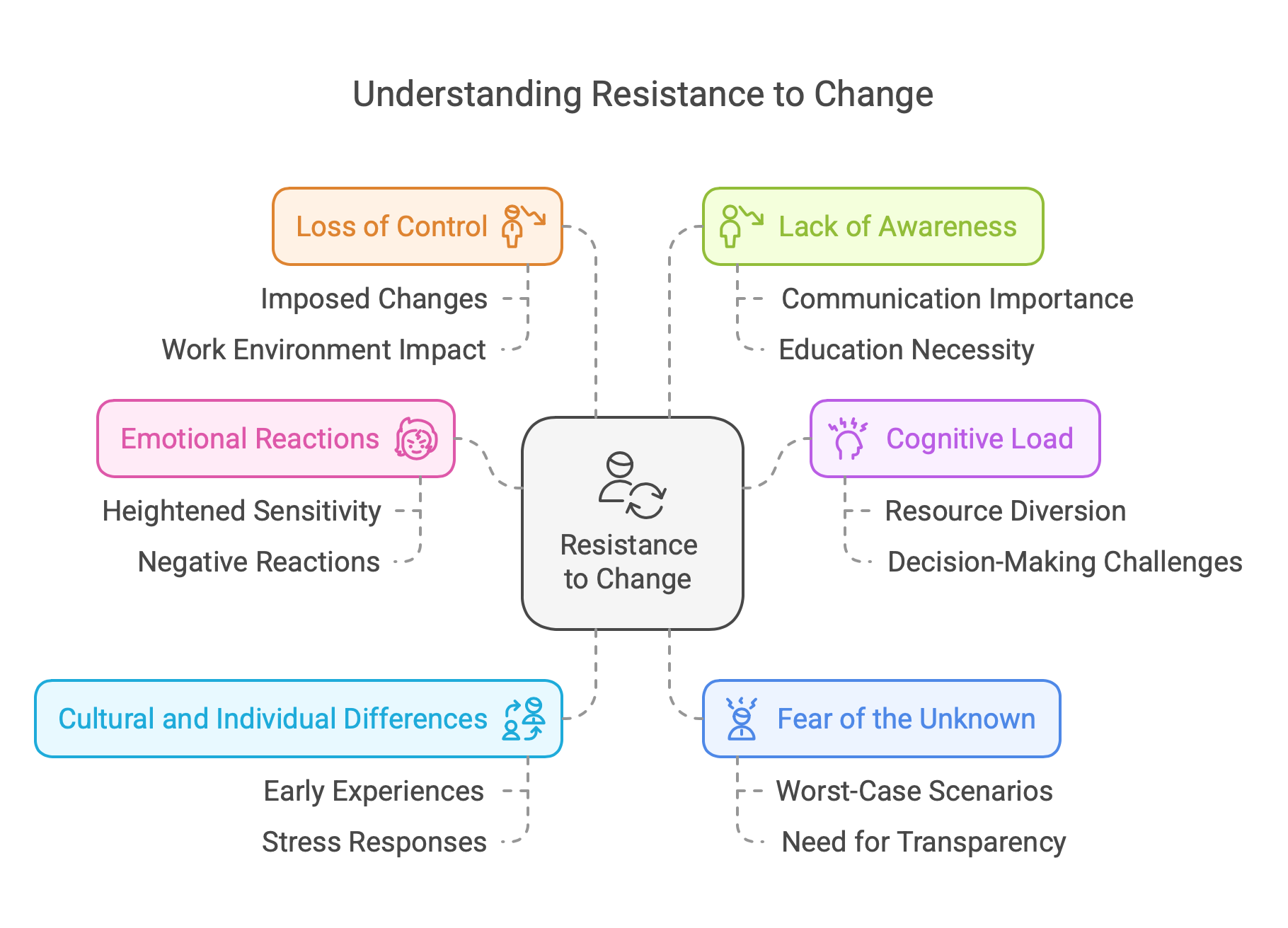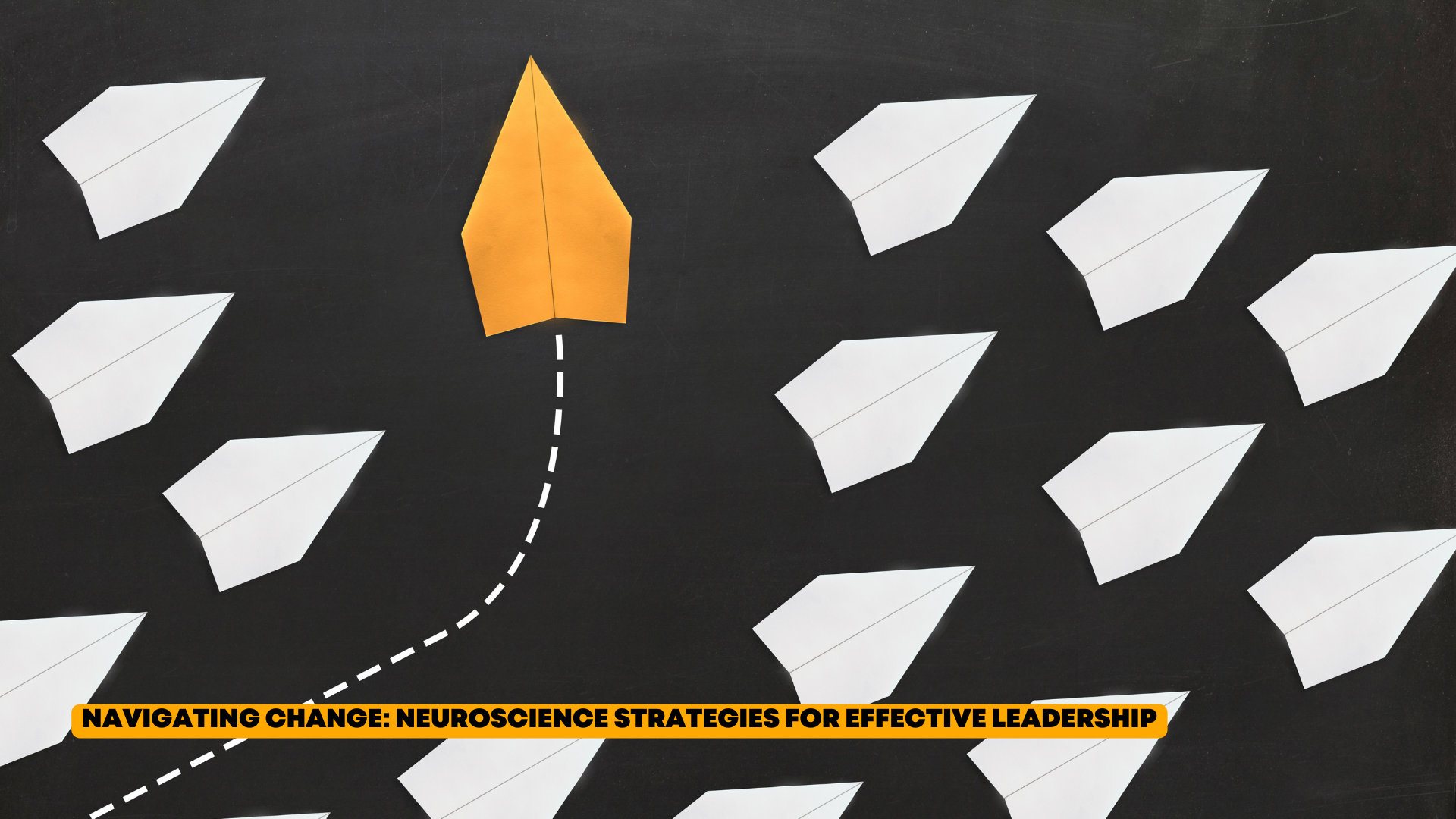Neuroscience and L&D: Overcoming Resistance to Change
The struggle with change is a universal headache in the business world. But there’s a way to turn this resistance into a high-five-worthy triumph. Yep, it’s time to bring out the big guns— neuroscience!
Now, before you imagine lab coats and brain scans, let’s keep it simple. Think of your brain like a superhero in a blockbuster movie. It’s got all these fantastic powers but also a few kryptonite-like weaknesses. And when it comes to change, those weaknesses can make even the most logical updates feel like trying to outrun a tsunami with a tricycle.
So why does our brain resist change?
It’s wired that way!
Our brain’s main job is to keep us safe, and change… well, it’s like that mysterious package on your doorstep. Could be a gift, could be a trap. Our brain opts for caution. But by understanding how our brains work, we can trick them into seeing change not as a threat but as a thrilling new adventure.
Imagine you’re at a company meeting, and the big bosses announce a major shift, maybe a new software, or a restructuring of teams. Cue the collective groan.
You can almost hear the thought bubbles:
“Not again!” “What’s wrong with the old way?” “Is this going to make my job harder?”
Sound familiar? This is where neuroscience swoops in with a cape and a plan.
In this article, we’ll dive into the brain’s quirky resistance mechanisms and how you, as the L&D superhero, can outsmart them. We’ll share practical, brain-friendly strategies to ease the fear and frustration, turning those groans into cheers (or at least reluctant nods).
Understanding Resistance to Change
Imagine your brain as a cozy little village. It’s safe, predictable, and the villagers (neurons) know exactly what to expect each day. Suddenly, someone announces that all the houses are going to be replaced with futuristic pods. Panic! Why? Because the villagers have no idea if these new pods are safe or comfortable. This is your brain’s reaction to change.
The Science Behind It: Our brains are hardwired to seek safety and stability. When faced with change, the brain’s amygdala—the part responsible for our fight-or-flight response—lights up like a Christmas tree. This triggers fear and anxiety, making us instinctively resist the unknown. According to Dr. Britt Andreatta, all change activates these survival centers in the brain, causing resistance and fatigue.
Emotional Reactions: Beyond the fear, there’s a whole cocktail of emotions at play. Neuroscientist David Rock explains that when our brains are in a “threat state,” even minor changes can feel like major threats. This heightened sensitivity means people might react negatively to even small adjustments at work.
The Cognitive Load: Ever felt completely drained by change? That’s because it consumes a ton of cognitive energy. When the brain perceives a threat, it diverts resources away from the prefrontal cortex—the area responsible for rational thinking and decision-making. This makes it harder to process new information and adapt to changes.
Cultural and Individual Differences: Not everyone reacts to change the same way. Some people thrive in a constantly changing environment (lucky them!), while others struggle with even the smallest shifts. This variance can often be traced back to early experiences and individual differences in stress responses.
Fear of the Unknown: When we don’t know what’s coming, our brains fill in the blanks with worst-case scenarios. This is why transparency and clear communication are vital in managing change.
Loss of Control: Feeling out of control is another major trigger for resistance. When changes are imposed without input or explanation, people can feel like they’re losing their grip on their work environment, which only amps up the resistance.
Lack of Awareness: Often, resistance stems from simply not understanding why change is necessary. If people don’t see the benefits or understand the reasoning, they’re much more likely to dig in their heels. This is where effective communication and education come into play.
Understanding the brain’s natural aversion to change gives us the power to counteract it. By recognizing these triggers and addressing them head-on, we can create a smoother, less stressful transition for everyone involved. Next up, we’ll dive into some brain-friendly strategies to make change not just palatable, but maybe even… exciting!
Key Factors Contributing to Resistance
Alright, let’s dig into the juicy details of why change feels like such a mountain to climb for so many. Spoiler alert: It’s not just one thing—it’s a cocktail of factors that together make resistance to change almost inevitable. But don’t worry, understanding these factors is the first step in overcoming them!
Fear of the Unknown
Imagine you’re on a road trip, and suddenly, your GPS stops working. Panic sets in, right? That’s what the brain feels when faced with unknown changes. It’s wired to favor predictability because it equates the familiar with safety. When change looms, the uncertainty triggers anxiety, making people cling to the known even if it’s not perfect. For example, employees might resist a new project management tool because they aren’t sure how it will impact their day-to-day tasks. They worry about potential pitfalls they can’t foresee.
Loss of Control
Let’s face it: nobody likes feeling powerless. When changes are imposed from the top down without employee input, it can feel like the rug is being pulled out from under them. This perceived loss of control can significantly heighten resistance. Imagine a company suddenly switching to a new software without consulting its users—employees are likely to push back because they feel their needs and opinions weren’t considered. This sense of helplessness fuels strong emotional resistance.
Emotional Triggers
Our emotions play a massive role in how we perceive change. The limbic system, which governs our emotions, often hijacks our response to change, making us react irrationally. For instance, an employee might resist a change in team structure not because it’s a bad idea, but because it stirs up memories of a past reorganization that led to layoffs. This emotional baggage can cloud judgment and fuel resistance.
Cognitive Overload
Change can be mentally exhausting. When the brain perceives a threat, it diverts resources away from the prefrontal cortex, which is responsible for rational thinking and decision-making. This cognitive overload can make it difficult for employees to process new information and adapt to changes. For instance, if a company rolls out multiple major changes at once—new software, a restructuring, and updated policies—employees might feel overwhelmed and resist because they simply can’t keep up.
Cultural and Individual Differences
Not everyone sees change the same way. Cultural backgrounds and personal experiences shape how individuals respond to change. For instance, someone who grew up in a stable, supportive environment might embrace change more readily than someone whose early life was marked by instability. Similarly, cultural attitudes toward authority and uncertainty can influence resistance levels. A company with a diverse workforce needs to consider these differences when implementing change to ensure all employees feel supported.
Lack of Awareness
A significant chunk of resistance comes from not understanding the “why” behind the change. When employees don’t see the rationale or the benefits, they are more likely to resist. Clear, transparent communication is key here. For example, if management decides to implement a new performance review system but fails to explain how it will help employees grow and succeed, skepticism and resistance are almost guaranteed.
Strategies to Overcome Resistance
Alright, change warriors, now that we’ve unpacked why our brains naturally resist change, let’s dive into some battle-tested strategies to turn that resistance into readiness. It all starts with…
1. Effective Communication
Communication isn’t just about relaying information; it’s about creating a dialogue that fosters understanding and trust. Think of it as the secret sauce that can turn a bland, scary change into a palatable, even exciting, prospect.
Clarity and Transparency
People fear what they don’t understand. Clear, transparent communication can demystify change and reduce anxiety. Explain the “why” behind the change in straightforward terms. For instance, if your company is adopting new software, outline the specific benefits: “This new tool will cut down on repetitive tasks, freeing up more time for creative work.” Avoid jargon and corporate-speak—keep it simple and relatable.
Frequent Updates
Keep the lines of communication open. Regular updates prevent rumors and misinformation from filling the void. Use multiple channels—emails, meetings, newsletters, and even informal chats. Imagine you’re steering a ship through a storm; you wouldn’t just set the course and disappear. You’d check in, adjust the sails, and reassure your crew along the way.
Two-Way Dialogue
Make it a conversation, not a monologue. Encourage feedback and listen to concerns. This shows respect and can provide valuable insights into potential issues you might have overlooked. For example, during a departmental restructuring, hold town hall meetings where employees can ask questions and express their worries. This engagement can build a sense of ownership and reduce resistance  .
Emotional Engagement
Don’t just focus on the rational reasons for change; address the emotional side too. Share stories that highlight positive outcomes from past changes. Use empathy to acknowledge the discomfort and fears employees might be feeling. “I know this new process feels daunting, but remember when we switched to the new email system last year? It was tough at first, but now it’s saving us hours each week.”
Visual and Interactive Tools
People process information in different ways. Use visuals like infographics, videos, and interactive Q&A sessions to make your message more engaging. For instance, create a short video demonstrating how the new software works and how it will benefit the team.
Consistency
Ensure the message is consistent across all levels of the organization. Mixed messages can create confusion and erode trust. Everyone from top management to team leads should be on the same page about the reasons for the change and the benefits it will bring.
Personalization
Tailor your communication to different audiences within the organization. What resonates with the IT department might not work for the marketing team. Understand the unique concerns and motivators of each group and address them specifically. For example, tech teams might appreciate detailed technical benefits, while sales teams might be more interested in how the change will improve customer interactions.
For example, a tech company rolling out a new customer relationship management (CRM) system. Initially, there was significant pushback because employees were comfortable with the old system. The company tackled this with a robust communication plan:
Initial Announcement: A clear, enthusiastic message from the CEO explaining the reasons for the switch and the expected benefits.
Follow-Up Meetings: Department-specific meetings where managers discussed how the new CRM would impact their teams and addressed specific concerns.
Training Sessions: Interactive training sessions, complete with hands-on demonstrations and Q&A opportunities.
Regular Updates: Weekly newsletters with tips, success stories, and progress updates.
Feedback Channels: Open forums and suggestion boxes for ongoing feedback.
This comprehensive approach helped ease fears, built trust, and facilitated a smoother transition.
2. Leadership and Empathy
Leadership isn’t just about making decisions; it’s about inspiring and guiding your team through uncertain waters. Effective leaders play a critical role in reducing resistance to change by modeling the behavior they want to see and by being transparent, approachable, and supportive.
Empathetic Leadership
Empathy is your superpower here. Empathetic leaders understand the emotional landscape of their teams and address concerns with genuine care. According to Jason A. Hubbart, inclusive and empathetic leadership can significantly enhance the acceptance of organizational change.
Leading by Example
Leaders must walk the talk. When leaders visibly embrace change and demonstrate its benefits, it sets a powerful example. For instance, if a new software system is being implemented, leaders should be among the first to adopt it and share their positive experiences.
Listening and Involving
Effective leaders listen more than they speak. They actively seek input from their teams, making employees feel valued and involved in the change process. This can be done through regular feedback sessions, one-on-one meetings, and anonymous surveys. A leader who listens and adapts based on employee feedback can significantly reduce resistance.
Building Trust
Trust is the bedrock of any successful change initiative. Leaders build trust by being consistent, honest, and reliable. They keep promises and follow through on commitments. Trustworthy leaders can more easily convince their teams to follow them into new and unfamiliar territories.
Emotional Intelligence
Leaders with high emotional intelligence can better understand and manage their own emotions and those of their team members. This skill is crucial when navigating the emotional turbulence that often accompanies change. Leaders can use their emotional intelligence to read the room, offer support where needed, and celebrate small wins to keep morale high.
For example, a tech company that underwent a significant restructuring. Initially, there was widespread anxiety and pushback. The CEO, known for her empathetic leadership style, took the following steps:
Open Forums: Held open forums where employees could voice their concerns and ask questions. She listened attentively and addressed each point honestly.
Personal Stories: Shared her own experiences with change, including the challenges and benefits, which helped humanize the process.
Visible Commitment: Demonstrated her commitment by being the first to adapt to the new structure, showing that she was in it with her team.
Ongoing Support: Provided ongoing support through regular check-ins, acknowledging the emotional impact and offering resources for stress management.
This empathetic approach helped ease fears, build trust, and foster a more cooperative attitude towards the restructuring.
Empathy and strong leadership are crucial in managing change. Leaders who understand and address the emotional and practical concerns of their teams can significantly reduce resistance and foster a more positive, adaptable organizational culture.
3. Gradual Implementation
Our brains love predictability and routine, so sudden changes can feel like an ambush. By implementing changes gradually, you give people time to adjust, learn, and adapt at a comfortable pace. This reduces the cognitive load and stress associated with change, making the transition more manageable.
Break It Down
Instead of rolling out a massive change all at once, break it down into smaller, more digestible parts. For example, if you’re introducing a new company-wide software, start with one department, gather feedback, make necessary adjustments, and then proceed to the next. This phased approach helps in identifying and solving issues early, reducing overall resistance.
Pilot Programs
Pilot programs are a great way to test changes on a smaller scale before a full rollout. Let’s say you’re implementing a new performance review process. Start with a pilot group, gather their feedback, refine the process, and then expand. This not only helps in refining the change but also creates change champions who can advocate for the new process.
Training and Support
Provide ample training and support throughout the gradual implementation. Offer workshops, tutorials, and one-on-one sessions to ensure everyone feels equipped to handle the change. Continuous support is key. Think of it like training wheels on a bike—eventually, you’ll be able to take them off, but they’re crucial for those first wobbly attempts.
Regular Check-Ins
Hold regular check-ins to assess how the change is being received and address any concerns promptly. These can be formal meetings or informal catch-ups. The goal is to create a feedback loop where employees feel heard and supported. For instance, if a new customer service protocol is being phased in, weekly team huddles can help identify and resolve any hiccups quickly.
Adjust and Adapt
Be flexible and willing to adapt based on feedback. Change isn’t a one-size-fits-all process. What works for one team might need tweaking for another. Showing that you’re responsive to feedback not only improves the change process but also builds trust and reduces resistance.
Examples
An educational institution decided to integrate a new online learning platform. Instead of a sudden switch, they opted for a gradual implementation:
Phase 1: Pilot program with a small group of teachers and students. Feedback was collected and used to make improvements.
Phase 2: Expanded to one grade level. Additional training sessions were provided based on the pilot feedback.
Phase 3: Full implementation across all grades, with ongoing support and regular feedback sessions.
This phased approach allowed the institution to fine-tune the platform and training materials, leading to a smoother transition and higher acceptance rates.
A multinational corporation introduced a new project management tool. They avoided a big-bang approach and instead:
Pilot Test: Selected one department for a three-month pilot.
Feedback and Adjustments: Collected feedback, made necessary adjustments, and developed comprehensive training based on real user experiences.
Gradual Rollout: Rolled out the software to one department at a time, providing full support and training to each.
Full Adoption: After ensuring that each department was comfortable and proficient with the new tool, the software was fully adopted company-wide.
The gradual implementation not only minimized disruption but also allowed employees to adapt at their own pace, reducing resistance and increasing overall satisfaction.
Gradual implementation is like taking baby steps towards a big goal. It allows everyone to get used to the idea of change, reduces the fear of the unknown, and provides ample time for training and adaptation. This strategy not only minimizes resistance but also fosters a culture of continuous improvement and adaptability.
4. Training and Development
Remember the first time you tried to ride a bike? Without training wheels, it was a wobbly, nerve-wracking experience. The same goes for implementing change in an organization. Proper training helps employees feel confident and competent, reducing anxiety and resistance. It’s all about setting them up for success from the get-go.
Comprehensive Training Programs
Start with a solid training plan that covers all aspects of the change. This should include not just the “how-tos” but also the “whys.” For example, if you’re introducing new software, your training should explain how to use it and why it’s being implemented—how it will make their jobs easier, improve efficiency, etc. This dual approach ensures that employees see the value in the change and understand how to navigate it.
Interactive and Hands-On Learning
People learn best by doing. Incorporate interactive, hands-on training sessions where employees can practice using new tools or processes in a low-pressure environment. Think workshops, simulations, and role-playing exercises. For instance, a retail company introducing a new point-of-sale system could set up mock transactions for employees to practice on before the system goes live.
Continuous Learning Opportunities
Training shouldn’t be a one-and-done deal. Provide ongoing learning opportunities to help employees keep honing their skills and adapting to changes. This could be in the form of regular refresher courses, advanced training sessions, or access to an online learning platform. For example, offering quarterly workshops on new features or updates keeps everyone in the loop and proficient  .
Personalized Training Paths
Not everyone learns at the same pace or in the same way. Tailor training programs to meet the diverse needs of your workforce. This could mean offering different levels of training (beginner, intermediate, advanced) or providing resources in various formats (videos, written guides, one-on-one coaching). Personalized training ensures that everyone gets the support they need to succeed.
Support and Resources
Make sure that employees have access to support and resources throughout the transition. This includes having a dedicated helpdesk, online FAQs, user manuals, and access to experts who can provide guidance. Think of it like having a coach on the sidelines, ready to jump in and assist whenever needed.
Encouragement and Reinforcement
Celebrate small wins and progress along the way. Positive reinforcement can boost morale and build momentum. For example, if a team successfully completes a training module, acknowledge their effort and success—maybe even with a small reward or public recognition. This helps to create a positive association with the change process.
Examples in Practice
A financial services firm was implementing a new customer relationship management (CRM) system. They approached training with a multi-faceted plan:
Initial Training: Conducted comprehensive training sessions explaining both the “how” and “why” of the new system.
Hands-On Workshops: Organized interactive workshops where employees could practice using the system with real-world scenarios.
Ongoing Support: Established a helpdesk and created an online resource center with FAQs, video tutorials, and user guides.
Advanced Training: Offered advanced courses for employees who wanted to deepen their knowledge and skills.
Recognition Programs: Implemented a recognition program to celebrate employees who quickly adapted and excelled in using the new CRM.
Training and development are the lifelines of successful change management. By providing comprehensive, interactive, and continuous training, you equip your team with the skills and confidence to embrace change. Personalized training paths, ample support, and positive reinforcement further smooth the transition, turning resistance into readiness.
Why This Matters
Let’s be real, navigating change can feel like herding cats, especially when the natural response is to resist. By understanding the brain’s quirks and leveraging strategies that align with how we’re wired, we can transform resistance into readiness.
What We’ve Learned
Effective Communication: It’s all about clear, transparent, and engaging dialogue. Think of it as setting up a GPS for your change journey, no more wandering in the dark!  
Leadership and Empathy: Lead with your heart and your head. Empathy, trust, and emotional intelligence are your secret weapons to win over your team and guide them through change smoothly  .
Gradual Implementation: Baby steps, folks. Breaking down change into manageable chunks makes it less intimidating and more digestible, much like enjoying a big chocolate cake one slice at a time  .
Training and Development: Equip your team with the tools and knowledge they need. Continuous, interactive, and personalized training ensures everyone feels confident and capable, turning them into change superheroes  .
Your Next Steps
Now, it’s your turn to be the change maestro. Use these strategies to craft a change management plan that’s as smooth as a well-choreographed dance. Remember, it’s about making the journey as comfortable and supportive as possible for your team.
Change doesn’t have to be a dreaded monster lurking in the shadows. With the right approach, it can be a thrilling adventure that brings growth, innovation, and success. So, gear up, embrace these neuroscience-backed strategies, and lead your team to victory!
















